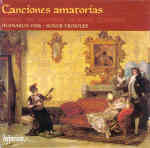Together with exemplary accompanist Roger Vignoles, Buenos Aires-born mezzo-soprano Bernarda Fink has assembled a delightful recital of 27 20th-century Spanish-language songs. Granados, Rodrigo, and Ginastera all make their appearances, as do two less-often-heard composers: Cuba’s Joaquín Nin, who was raised in Spain (and happens to be writer Anaïs Nin’s brother), and Carlos Guastavino from Argentina, whose compositional output was very much focused on songs (he wrote about 200 works for voice and piano). Even within the strictures of the program’s focus, its diversity of repertoire is stunning, and the composers’ artistic voices are entirely distinct, perhaps even familiar. We hear a delicate piano line in Rodrigo’s “Pastorcito santo” that recalls his works for harp, along with Granados’ pretty seven-song cycle Colección de cancíones amatorías, in which the piano is an equal partner to the vocalist (not surprising from the composer of Goyescas).
But a great deal of the program’s beauty lies in the way Spanish and Latin American composers integrate art and popular music. There’s a sizzling tango in Ginastera’s “Cancion al arbol del olvido” that’s straight from the streets of Buenos Aires, and Nin’s songs pick up a number of traditional folk songs and dances, including the fiery “El vito”, traditionally performed for an audience of bullfighters. Guastavino takes a more tender, lyrical tone: the three songs here (“La rosa y el sauce”; “Cita”; and “La palomita”) may strike you as syrupy at first, but their tenderness is irresistible on repeated listening.
Fink is generally in very fine form here, but there are a few moments in which she pushes too hard at the top of her register and turns shrill and hard, as in Ginastera’s “Triste” from the Cinco canciones populares argentinas. However, when she relaxes and goes for a lighter touch, she’s a delight. Vignoles is in a league of his own; there isn’t a another artist in his field who captures the emotional subtext of songs the way he does. The sound is clean, but occasionally the bright piano is more powerful than need be. [8/2/2002]
































